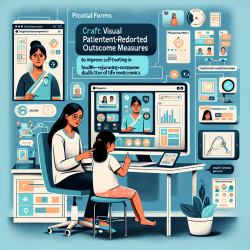Introduction
As practitioners dedicated to improving children's health outcomes, we must continually seek innovative ways to enhance our assessment tools. The recent systematic review, Exploring the Use of Pictorial Approaches in the Development of Paediatric Patient-Reported Outcome Instruments: A Systematic Review, sheds light on the effectiveness of pictorial patient-reported outcome measures (PROMs) in pediatric settings. This review underscores the potential of pictorial PROMs to facilitate self-reporting among children, particularly those who struggle with text-based formats.
The Importance of Pictorial PROMs
Pictorial PROMs integrate visual elements such as cartoons, smiley faces, and thermometers to represent health-related quality of life (HRQoL) domains. These tools are particularly beneficial for children who face difficulties with traditional text-based PROMs due to age, developmental delays, or chronic illnesses. The review identified 22 pediatric pictorial PROMs, which are predominantly used in the USA and UK, covering various domains like physical and emotional health, and social functioning.
Key Findings from the Systematic Review
- Child Participation: Involving children in the development of pictorial elements enhances content validity. The review found that 46% of the PROMs incorporated children's input during development.
- Graphic Methods: The use of diverse graphic methods, such as happy-sad faces and cartoons, tailored to specific content domains, improves children's engagement and understanding.
- Cross-Cultural Considerations: Only a few PROMs addressed cross-cultural applicability, highlighting an area for further research and development.
Implementing Pictorial PROMs in Practice
For practitioners, incorporating pictorial PROMs into practice can enhance the accuracy and reliability of child self-reports. Here are a few steps to consider:
- Select Age-Appropriate Tools: Choose PROMs that align with the developmental stage of the child.
- Engage Children in the Process: Involve children in the selection or development of pictorial elements to ensure relevance and engagement.
- Consider Cultural Contexts: Evaluate the cultural applicability of the PROMs to ensure they are suitable for diverse populations.
Conclusion
Pictorial PROMs offer a promising avenue for enhancing child self-reporting in clinical and research settings. By integrating visual elements, these tools can improve the accuracy of HRQoL assessments, leading to better-informed clinical decisions and improved outcomes for children. Practitioners are encouraged to explore these tools further and consider their integration into practice.
To read the original research paper, please follow this link: Exploring the Use of Pictorial Approaches in the Development of Paediatric Patient-Reported Outcome Instruments: A Systematic Review.










